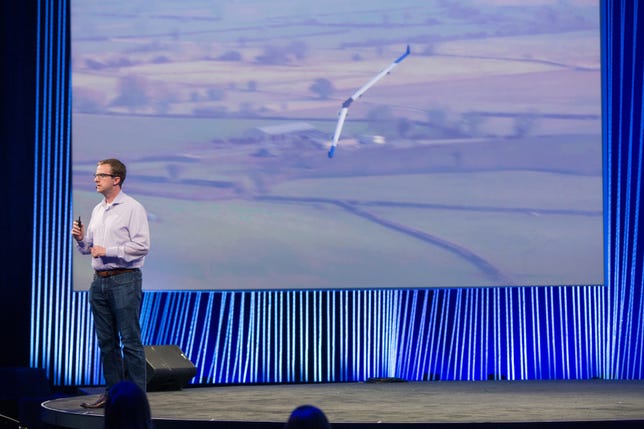
It’s a bird! It’s a plane! It’s…a giant Internet router?
That could be the reaction later this year when Facebook gets its high-flying, wide-wingspan drone off the ground.
At its F8 conference on Thursday, Facebook revealed that it had made a first test flight of an unmanned aerial vehicle. That drone, though, was a small-scale model — used to test out the aerodynamics — of a much larger, and solar-powered, one that the company aims to send aloft as it works to bring the Internet to millions more people around the world.
The big Facebook drone, called Aquila, will hold its first test flight this summer, Facebook vice president of engineering Jay Parikh told the Wall Street Journal in an interview published Thursday.
“The idea of this,” Facebook’s chief technology officer, Mike Schroepfer, told an audience at F8, “is to loiter across an area at very high altitude — 60,000 to 90,000 feet in the air — stand on station for months at a time and beam down backbone Internet access.”


Now playing:
Watch this:
Facebook CTO talks up solar-powered drones
1:08
The boomerang-shaped Aquila will weigh only about as much as a small car, but will have the wingspan of a Boeing 737. Those dimensions are similar to the proportions of the Solar Impulse 2 aircraft, which carries a human pilot and which earlier this month embarked on a first-ever round-the-world journey. In both designs, the solar panels are built into the wings.
The use of solar energy could help with the aspirations to keep the aircraft aloft for “months at a time.” The earlier prototype Solar Impulse aircraft charged its batteries as it flew during the day and then drew on that energy to keep flying through the night. But aircraft with pilots aboard can quickly run into the limitations of human endurance.
Drones are another matter. In 2010, a lightweight, solar-powered unmanned aircraft called the Qinetiq Zephyr set a remarkable world record, flying nonstop for just over 336 hours — that is, two full weeks.
By comparison, Boeing has been test-flying, in short spurts, a liquid hydrogen-powered unmanned aircraft called the Phantom Eye that it wants eventually to be capable of four days of unrefueled autonomous flight. Northrop Grumman’s remotely piloted Global Hawk has flown for as long as 34 hours.
The Aquila mission is part of a broader desire on the part of Facebook, the world’s largest social network, to bring Web access to underserved countries through its Internet.org initiative. Internet.org is looking into a wide range of technologies, including lasers and satellites, that could be used to beam Internet access to people around the globe.
Under the program, the drones would fly over areas where Internet access is either unavailable or spotty at best.
“Aircraft like these will help connect the whole world because they can affordably serve the 10% of the world’s population that live in remote communities without existing internet infrastructure,” Facebook CEO said in a post to the social network.
Internet giant Google, meanwhile, has its own aerial programs to help people get online. Project Loon, developed by the company’s oft-secretive Google X laboratory, aims beam Internet access from balloons. Google also has a drone program in the works.
Parikh told the Journal that it’s unlikely that Facebook will have a real program in place anytime soon, saying that the company needs to adequately test safety and feasibility before drones offering Internet access are actually put into action. He didn’t say when the program might launch.
There’s also the issue of where that access comes from. According to the Journal, Facebook is content to partner with mobile carriers to offer Web access and will not provide its own service to users.
Facebook declined to comment on Parikh’s statements.




